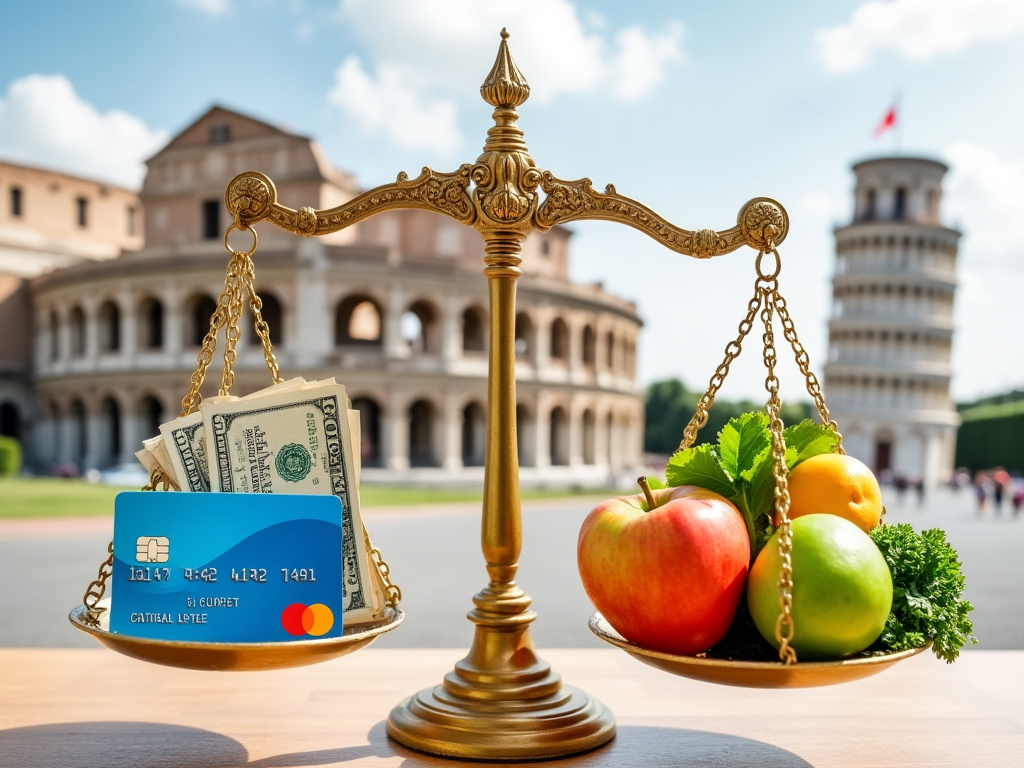Thinking about moving to Italy or applying for Italian citizenship? One of the biggest considerations is the cost of living in Italy. Whether you’re an Italian descendant looking to relocate or just curious about the expenses associated with living in Italy, this detailed guide covers all the essential costs, from rent and groceries to transportation and healthcare. Let’s explore how much it really costs to live in Italy and what you need to budget for a smooth transition.
Introduction: Understanding the Cost of Living in Italy
Italy is one of the most popular destinations in Europe, known for its rich culture, stunning landscapes, and delicious cuisine. But how expensive is it to live there? The cost of living in Italy varies depending on the region, lifestyle, and individual preferences. In this guide, we’ll break down the typical expenses you’ll encounter, whether you’re living in a large city like Rome or a small town in Tuscany. From housing to health insurance, you’ll get a clear idea of the expenses you need to plan for.
Housing Costs in Italy
Housing is often the largest cost of living in Italy. Prices fluctuate based on whether you’re living in a major city, coastal town, or rural village. For finding homes or apartments for rent or purchase in Italy, I recommend exploring Idealista and Casa.it, both of which offer extensive listings across the country.

Renting a Home in Italy: Costs for 2 People vs. a Family of 4
When renting a home in Italy, the cost varies based on the size of the apartment, city, and the number of occupants. Below is a breakdown of typical rental costs for both two people and a family of four in different regions of Italy.
Rome
- For 2 People:
- One-bedroom apartment in the city center: €1,200 – €1,500 per month.
- One-bedroom apartment outside the center: €800 – €1,100 per month.
- For a Family of 4:
- Two-bedroom apartment in the city center: €1,800 – €2,500 per month.
- Two-bedroom apartment outside the center: €1,200 – €1,600 per month.
Milan
- For 2 People:
- One-bedroom apartment in the city center: €1,300 – €1,700 per month.
- One-bedroom apartment outside the center: €900 – €1,200 per month.
- For a Family of 4:
- Two-bedroom apartment in the city center: €2,000 – €2,800 per month.
- Two-bedroom apartment outside the center: €1,200 – €1,700 per month.
Smaller Towns (e.g., Siena, Bari)
- For 2 People:
- One-bedroom apartment: €400 – €700 per month.
- For a Family of 4:
- Two-bedroom apartment: €600 – €1,000 per month.
Utilities
- For 2 People: Monthly utilities (electricity, heating, water, garbage) typically range from €150 – €250.
- For a Family of 4: Utilities will cost around €200 – €350, depending on usage.
Buying a House in Italy
The cost of buying property depends heavily on location. In the countryside, you can find homes for as little as €50,000, but in larger cities or tourist hotspots like Florence or Venice, prices can exceed €500,000.
- Rome: Average price per square meter is around €3,500 to €5,500.
- Milan: Prices range from €4,000 to €6,500 per square meter.
- Countryside: Expect lower prices, often between €1,000 and €2,000 per square meter.
Home insurance in Italy typically costs between €200 and €500 annually, depending on the location and value of the property.
Daily Living Expenses in Italy

Groceries
Monthly groceries for a family of four typically cost between €300 and €600, depending on your shopping habits.
- Bread (500g): €1.50
- Milk (1L): €1.20
- Eggs (12): €2.50
- Chicken (1kg): €8
- Cheese (500g): €6
- Pasta (1kg): €1.50
Shopping at local markets can help you save money and also offers fresher products.
Dining Out
- Restaurants: A meal at a mid-range restaurant costs around €15 to €30 per person.
- Fast food: A combo meal at McDonald’s or a similar chain is about €8.
- Cappuccino: You can enjoy one for just €1.50 at a local café.
Transportation Costs in Italy
Public Transportation
Public transportation in Italy is reliable and affordable.
- Monthly transport pass: In cities like Rome and Milan, a monthly pass costs around €35 to €50.
- Single ticket: A one-way ticket costs between €1.50 and €2 depending on the city.
Buying a Car in Italy
If you prefer driving, you’ll need to consider the cost of purchasing and maintaining a vehicle.
- Cost of buying a car: A new small car (e.g., Fiat Panda) starts at around €10,000, while used cars can cost anywhere from €5,000 to €15,000.
- Car insurance: Annual premiums range between €300 and €800, depending on the car model and your driving history.
- Fuel: Gasoline costs around €1.85 per liter, making fuel a significant expense if you plan to drive regularly.
Additional Transport Costs
- Tolls: Italy’s highways often have tolls. Expect to pay between €5 and €10 for a moderate-length trip.
- Parking: Parking in cities can be expensive, with rates ranging from €1.50 to €3 per hour.

Health Insurance and Medical Costs in Italy
Italy’s healthcare system, Servizio Sanitario Nazionale (SSN), provides universal healthcare to all legal residents, including foreigners. While basic services are either free or available at low cost, many residents opt for private health insurance to access additional services and avoid long waiting times.
Public Healthcare Costs
As a legal resident in Italy, you are eligible for basic healthcare services through the SSN.
- Free or Low-Cost Services: Basic healthcare services, including doctor’s visits and hospital stays, are either free or available at a minimal cost.
- Co-pays (Ticket Fees): You may need to pay a small fee for certain treatments or specialist consultations. These co-pays range from €10 to €50 depending on the service and region.
- Prescription Medications: Prescription medications are partially covered under the public system, with typical out-of-pocket costs ranging from €5 to €25.
Private Health Insurance in Italy
For faster service, access to private hospitals, and more comprehensive care, many residents choose private health insurance.
- Basic Private Health Insurance: For basic coverage, annual premiums range from €500 to €1,000.
- Comprehensive Private Health Insurance: For coverage that includes dental and vision services, costs range from €1,200 to €1,500 per year.
Medical Consultation Costs
Private healthcare services are available at a cost, which varies based on the type of consultation.
- General Doctor’s Visit: A private consultation with a general practitioner costs between €50 and €100.
- Specialist Consultation: Visits to specialists, such as dermatologists or cardiologists, typically range from €80 to €200 depending on the location and specialty.
- Dental Services: A standard dental cleaning costs between €50 and €100, while more complex treatments such as fillings or extractions can cost €80 to €300.
Hospital Visits and Procedures
In public hospitals, urgent care is free. For non-urgent procedures in private facilities, costs are higher.
- Private Hospital Stay: A night in a private hospital costs between €300 and €600, depending on the hospital and services required.
- Minor Surgeries: Procedures such as mole removals or minor surgeries in private hospitals can range from €500 to €2,000.
Prescription Medication Costs
Prescription medication in Italy is relatively affordable, especially compared to other European countries.
- Prescription Drugs: The cost of common prescription medications typically ranges from €5 to €25.
- Over-the-Counter Medications: Non-prescription drugs, such as painkillers, usually cost between €5 and €15.
Summary of Health Insurance and Medical Costs in Italy
- Public Healthcare: Free or minimal co-pays, typically between €10 and €50.
- Private Health Insurance: Annual costs range from €500 to €1,500 depending on the coverage level.
- Doctor’s Visits: Private consultations cost €50 to €100, while specialist consultations range from €80 to €200.
- Prescription Medications: Out-of-pocket costs range from €5 to €25 for most prescriptions.
- Dental Services: Costs for dental care range from €50 to €300 depending on the complexity of the procedure.
Education and School Costs in Italy
If you’re relocating with children, you’ll want to know about the costs of education.

- Public schools: Free for residents, but parents must pay for books and materials, which can cost around €300 to €500 per year.
- Private schools: Tuition fees range from €5,000 to €12,000 per year, depending on the institution.
- University tuition: If you or your children are looking to attend university, tuition fees for public institutions range from €900 to €4,000 annually.
Leisure and Entertainment in Italy
Nightlife in Italy
The nightlife scene in Italy is particularly vibrant in cities like Rome, Milan, and Florence, where locals and tourists alike enjoy evenings out at bars, clubs, and live music venues.
- Drinks: Cocktails at bars in major cities cost between €8 and €12, with prices often higher at trendy or rooftop venues. A glass of wine typically costs €4 to €7, while local beer is usually priced at €5 to €8.
- Nightclubs: Entrance fees to nightclubs typically range from €10 to €20, which often includes one free drink. Exclusive or well-known clubs in cities like Milan may charge up to €30 for entry, especially on weekends.
- Live Music and Performances: Tickets for live music events, such as concerts, start at around €15 for smaller venues. Larger, more famous venues or international performances can cost anywhere from €50 to €150.

Outdoor Activities in Italy
Italy is famous for its stunning landscapes, offering a wide range of outdoor activities suitable for all types of travelers, from nature lovers to adventure seekers.
- Hiking: Italy has many free hiking trails, particularly in scenic areas such as the Dolomites, Cinque Terre, and Tuscany. Trails are well-marked, and many regions offer a variety of difficulty levels, making it accessible for families as well as experienced hikers. Some guided hikes or national parks may require a fee, generally around €10 to €20 for entry or a guide.
- Beach Visits: While Italy has many free public beaches, some of the more popular or well-maintained private beaches (particularly along the Amalfi Coast or Sardinia) charge an access fee. Renting a sunbed and umbrella typically costs between €5 and €15 per day, with luxury resorts charging even more, sometimes up to €30 per day for a full beach service package.
- Water Sports: In coastal regions, activities such as kayaking or paddleboarding are popular. Rentals for equipment typically range from €15 to €30 per hour, while guided tours can cost around €50 to €100 for a half-day experience.
- Cycling: In cities like Florence and Rome, renting a bike for a day costs about €10 to €15. In regions like Tuscany, guided bike tours through vineyards or countryside may cost between €50 and €100 per person.
Festivals and Cultural Events
Italy is also home to numerous festivals and cultural events throughout the year.
- Local Festivals: Many Italian towns hold free festivals celebrating food, music, or historical events. Costs might include small fees for food stalls or activities, typically €5 to €10 per item.
- Opera and Theatre: Tickets to see the opera or a play at famous venues like La Scala in Milan or the Teatro dell’Opera in Rome can range from €30 to €200, depending on the performance and seating.
Travel and Tourism Costs in Italy
Italy’s location makes it easy to explore Europe and beyond. However, there are costs associated with frequent travel.
- Flights within Italy: Low-cost carriers offer flights for as little as €30 to €100 for a round-trip between major cities.
- Train travel: High-speed trains, like the Frecciarossa, charge between €30 and €80 for a trip from Milan to Rome, depending on how early you book.

Technology and Communication Costs
Internet and Cell Phone Plans
Staying connected is essential, and Italy offers several affordable options for phone and internet services.
- Home internet: Expect to pay around €30 to €40 per month for a standard fiber optic connection.
- Cell phone plans: Many providers offer unlimited calls, texts, and data for around €10 to €30 per month. Popular providers include TIM, Vodafone, and WindTre.
Conclusion: Is Italy Expensive to Live?
The cost of living in Italy depends largely on your location and lifestyle. While cities like Rome and Milan can be expensive, smaller towns and rural areas offer more affordable living options. For a clearer perspective:
- In big cities like Rome or Milan:
- For 2 people, the average monthly cost of living (including rent, utilities, groceries, transportation, and other expenses) ranges from €2,200 to €3,500.
- For a family of 4, the average monthly cost rises to between €3,700 and €5,500, with housing and education typically being the largest expenses.
- In smaller towns:
- For 2 people, the monthly cost of living is generally more affordable, ranging from €1,200 to €2,500.
- For a family of 4, the average monthly cost falls between €2,200 and €3,500, with lower rent and grocery prices compared to major cities.
Housing and groceries are the biggest expenses, but public transportation is relatively cheap, and healthcare is highly affordable compared to many other countries. Whether you’re planning to relocate for work, retire, or gain Italian citizenship through ancestry, understanding these costs will help you budget effectively.
Now that you know the cost of living in Italy, are you ready to explore your Italian roots? Consult our extensive database of Italian registers to uncover your family’s history, and follow us on Instagram for more insights into Italian living and citizenship!

